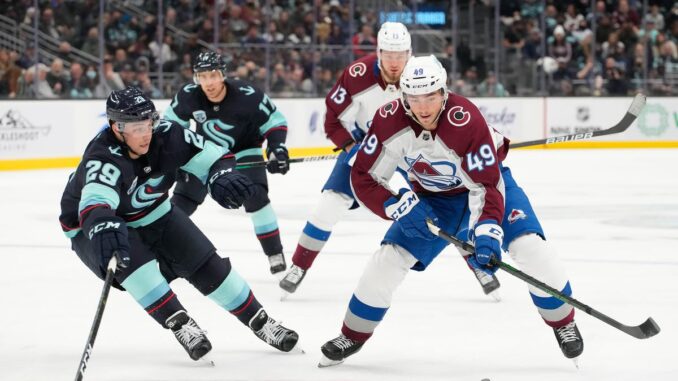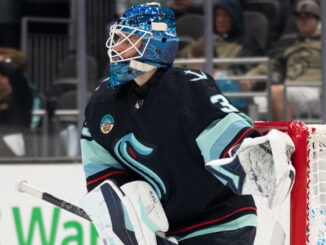
After one of the greatest second-season turnarounds in NHL history, the Seattle Kraken clinched a playoff spot as the Western Conference’s top wildcard seed.
In a cruel twist of fate, the reward for Seattle’s unexpected campaign was a date with the Colorado Avalanche – the defending Stanley Cup champions – in the first round.
Related: 2023 NHL Playoff Preview And Prediction – Seattle Kraken Vs. Colorado Avalanche
After winning the first game of the series but then losing two straight, the Kraken head into Game 4 (April 24) down 2-1 to the Avalanche and find themselves in a near must-win situation. Win, and the series becomes a best-of-three affair. Lose, and they go back to Colorado down 3-1 with a bloodthirsty home crowd egging on their opponents.
Beyond the context of the Kraken’s next game, let’s dive into three trends that have defined the first three games of the opening-round series and look to be integral to the final outcome.
Kraken Power Play Going Cold
One of the primary reasons for the Kraken’s early struggles has been their inability to convert on the power play with any regularity.
During the regular season, the Kraken’s power-play unit ranked 21st in the NHL with a success rate of 19.8%, a byproduct of a roster lacking a truly elite finisher. In the playoffs, their power play has been even less effective, converting on only one of their 11 opportunities through the first three games of the series (9.1%). In fact, their only goal with the man advantage came at the tail-end of Game 3 when the score was 6-3 in favor of the Avalanche.
The inability to capitalize on the man advantage has been a significant factor in the Kraken struggling to outscore the Avalanche to date. Still, it’s not just their finishing that’s let them down. The Kraken haven’t been able to generate shots or chances on the power play to any significant degree, giving them an even smaller margin for error when it comes to navigating poor shooting luck.
According to Natural Stat Trick, the Kraken are last among all playoff teams in shots, scoring chances, high-danger chances, and expected goals created per-60-minutes on the power play. It’s one thing not to finish the chances you do get, but the Kraken aren’t manufacturing anything of substance, to begin with.
Related: How The Seattle Kraken Qualified For The 2023 NHL Playoffs
One potential solution for the Kraken’s ailing power play could be to adjust their strategy. They may need to simplify their approach and focus on generating scoring chances of any kind rather than trying to squeeze the puck into the more dangerous scoring areas. Shots from the point are an ineffective method of generating offense, but when all else fails, why not try it?
Head coach Dave Hakstol may also need to consider making personnel changes on the top power-play unit to find a better combination of players who can generate results.
The Kraken had eight players either eclipse 20 goals this season or score at a 20-goal rate in fewer appearances, but only one eclipsed 30 tallies (Jared McCann with 40). It’s difficult to overcome a lack of shooting talent (especially when the Avalanche have two players who scored 40 or more goals), so some re-jigging of the lineup card may be necessary.
Avalanche Winning 5-on-5 Battle
Another issue for the Kraken has been their struggles at 5-on-5. Despite surprising the Avalanche in Game 1, Seattle has gradually seen their share of shots and scoring chances dwindle in each subsequent matchup.
| Statistic | Game 1 | Game 2 | Game 3 | Series |
| Shots | 50% | 43% | 44% | 46% |
| Scoring Chances | 53% | 46% | 40% | 47% |
| High-Danger Chances | 58% | 50% | 39% | 49% |
| Expected Goals | 46% | 45% | 39% | 43% |
It’s worrying that after earning an unexpected 1-1 split in Colorado, the Kraken played arguably their worst game of the series in the franchise’s highly anticipated first-ever home playoff game. They were easily handled and only made the final score palatable after the aforementioned late powerplay goal in Game 3.
On the series as a whole, the Kraken’s numbers don’t look terrible, but it’s the underlying trends that should cause the coaching staff some distress. Without a reliable power play to lean on, losing the 5-on-5 battle gives the Kraken even fewer opportunities to climb over the Avalanche.
One area where they are holding their own is in terms of creating havoc in front of the net. Through the first three games, both the Avalanche and Kraken have created 17 rebound opportunities at 5-on-5, which usually leads to the highest quality of chances. If they can continue to find their way into the slot area, they may be able to overcome their lower overall share of shots.
Kraken Struggling to Defend Leads
Lastly, the Kraken have struggled to defend their leads in the series, handing the Avalanche a lifeline on multiple occasions.
After decisively taking Game 1 by a 3-1 scoreline, the Kraken looked to have the Avalanche on the ropes. They had a 2-0 lead at the end of the first period, punctuated by a momentum-killing shorthanded goal by winger Brandon Tanev, and likely figured they were headed back to Seattle with a wholly unexpected 2-0 series lead.
Instead, the Avalanche outshot the Kraken 31-18 over the final two periods (and 15-6 in the third) and struck twice in the span of a minute to tie the game in the second before scoring late in the third to secure the win.
In Game 2, they once again got out to an early lead but conceded two goals in the final four minutes of the first period to head into the intermission down 2-1. They would fight back and tie the game at 3-3 at the end of the second but were outscored 3-1 in the third to once again lose a game that was within reach with 20 minutes to go.
Now, score effects are a real thing, and it’s tough to hold off any competent NHL team, let alone the Avalanche, but the Kraken have faltered under pressure. Any team hoping to win the Stanley Cup must be on the right side of the comeback ledger, and the Kraken have failed to stymie their opposition through three games.
The Kraken’s lack of postseason experience as a complete unit has shone through, but learning how to preserve leads is a step in any professional player’s evolution. Whether the group can learn an important lesson before it’s too late remains to be seen, but it’s integral teaching for the future.
Kraken Can Still Win the Series
Beyond the 2-1 series ledger, it bears repeating that the Kraken still have a chance to come back and win the series. Game 4 is once again a home game for the Kraken, and a win could swing the momentum back in their favor.
The power play struggles are problematic and could spell doom in a series where each of the first three games has been decided by two goals or fewer. The Kraken are due for some positive regression in shooting, but they’re not helping their case by generating an absurdly low rate of chances.
At 5-on-5, the problems are more challenging to solve. The Avalanche hold a clear advantage in the star talent department, although the Kraken can arguably roll out a stronger bottom six. It may be in those depth minutes where some damage can be done.
As for defending leads, the steely resolve needed to stay cool in high-pressure situations may only come with experience on both the individual and team levels. The Kraken have a few players with a history of going deep in the postseason, but those select few have rarely been pivotal pieces of their respective squads.
It will be a challenging road ahead and even more difficult if the Kraken find themselves in a 3-1 hole. The Kraken can point to upsetting expectations following a poor inaugural campaign and use that adversity in a constructive fashion. Strap in for Game 4. It’s poised to be a barnburner.
Data courtesy of Natural Stat Trick and the NHL.




